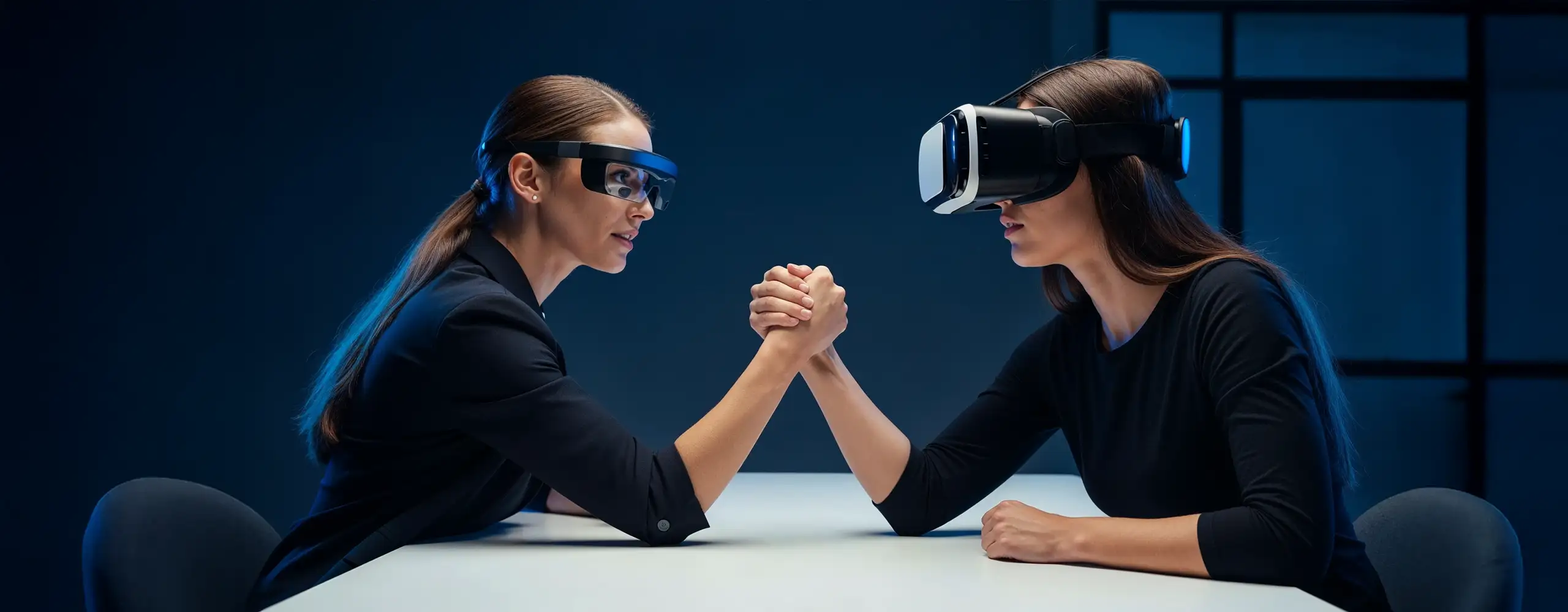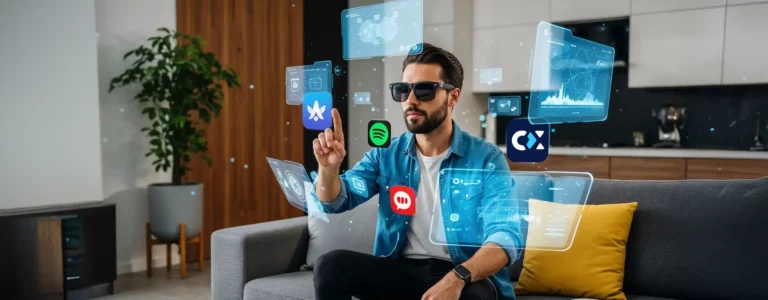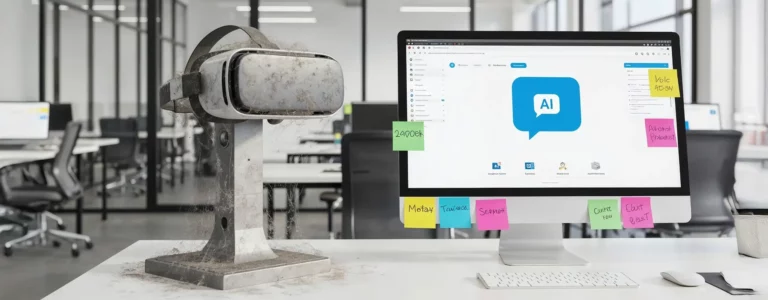During our “NeCXt: when Strategy meets Technology” episode focused on immersive technologies, I had the opportunity to discuss the future of VR and AR with Amy Peck, founder of EndeavorXR and a recognized figure in extended reality. Her vision particularly struck me because it goes beyond the traditional opposition between these technologies to reveal their natural complementarity.
VR vs AR: Virtual Reality as a Dedicated Destination
Amy Peck has a very clear way of defining virtual reality:
“I think of VR as a destination. You go into VR to do something, to learn something, to experience something.”
This definition completely changes our approach to VR technology. Unlike other digital tools we use passively, virtual reality requires intention. You don’t “fall into” VR by accident, like you might check your phone unconsciously. You go there deliberately.
This characteristic explains why VR excels in specific domains:
• Immersive professional training
• Remote collaboration with 3D object manipulation
• Complex data visualization
• Educational or therapeutic experiences
VR addresses precise needs that require temporary total immersion. That’s its strength, but also what naturally limits its daily usage frequency.
Augmented Reality: The Invisibility That Transforms Everything
“AR, I think, will be much more ubiquitous than VR”
predicts Amy Peck. And her logic is flawless:
“AR essentially takes all this data that we interact with on 2D screens, whether on laptops or mobile devices, and projects it seamlessly into your field of vision.”
The augmented reality approach follows a radically different philosophy. Instead of taking us elsewhere, it enriches our immediate environment. This invisible integration into our daily lives explains its massive transformation potential.
Why mobile AR has its limits
Amy raises a crucial point about smartphone AR: holding your phone up to the real world doesn’t provide an optimal user experience over time, and this gesture remains cumbersome.
This limitation explains why AR adoption remains timid despite the technology being available on our smartphones for several years.
Mixed Reality and Spatial Computing: The Evolution of Augmented Reality
“Mixed reality: that’s where it gets really interesting. It’s an overlay or layer tied to your environment, and it’s location-aware.”
explains Amy Peck.
This distinction between simple AR and mixed reality is fundamental to understanding the coming evolution:
• Basic AR: Information overlay without spatial context
• Mixed reality: Intelligent anchoring of digital elements in the real environment
• Spatial computing: The world becomes our screen
Mixed reality transforms digital overlay into a truly intelligent assistant, capable of understanding your context and adapting information accordingly.
Enterprise VR AR Applications: Complementary Use Cases
Amy’s experience with her Fortune 500 clients reveals very distinct XR use cases depending on the chosen technology.
Training and collaboration in virtual reality
Enterprise VR excels in environments where total immersion provides measurable value:
• Simulating dangerous situations without real risk
• Training on expensive equipment without tying up machines
• 3D collaboration for geographically distributed teams
Operational assistance in augmented reality
Professional AR transforms operational efficiency:
• Assisted maintenance with instruction overlay on real equipment
• On-the-job training without interrupting production
• Quality control with automatic anomaly detection
The Future of Immersive Technologies: A Unified Reality Spectrum
Amy Peck shares a particularly enlightening vision for the future:
“In the future, we’re not going to be talking about what reality we’re in. We’re going to move fluidly through different levels of augmentation from real life to mixed reality, to spatial computing, all the way to completely computer-generated environments, and back again.”
This reality spectrum approach goes beyond VR versus AR opposition to envision a continuum of immersive experiences. We’ll naturally move from one level of immersion to another based on our momentary needs.
The conditions for this convergence
For this vision to materialize, Amy identifies several prerequisites:
• Truly wearable devices (not just “wearable” in name)
• Simple user interfaces that don’t require learning
• Daily utility comparable to our current smartphones
VR AR Adoption: Complementarity Rather Than Competition
Rather than seeking which technology will “win,” Amy’s approach invites us to rethink our expectations. VR and AR aren’t competitors but complementary, each addressing specific needs in the immersive technology ecosystem.
This complementarity is already observable in the strategies of the most advanced companies, which deploy VR and AR in parallel according to use contexts. The future won’t be about choosing between these technologies, but in their intelligent orchestration to serve our personal and professional objectives.
Once again, as with every technological advancement in the past, technology serves brand strategy. The brands that will best leverage these technological advances will be those that have anchored their strategy in their brand DNA, have a solid understanding of their customers, and have implemented a useful approach to technology. And that’s exactly the DNA of NeCXt Impact Consulting…
Do these insights resonate with your business challenges? Contact us to dive deeper into these questions and their application in your industry.
Amy Peck is founder of EndeavorXR, advisor to Fortune 500 companies, and ranks among the top 100 women of the future. Her expertise in extended reality enables her to guide organizations in the strategic adoption of immersive technologies.
David Smadja guides leaders through digital and marketing transformation. Former CMO at McDonald’s, ex-Nestlé with agency digital beginnings, he helps companies navigate technological disruptions and adapt their strategies to new consumer behaviors.
Article from podcast #3:
Rethinking Reality : How XR is quietly reshaping Business with Amy Peck






